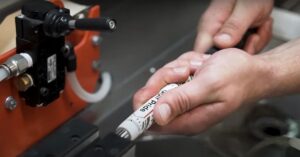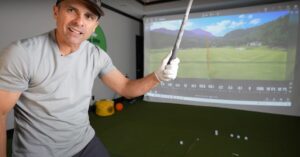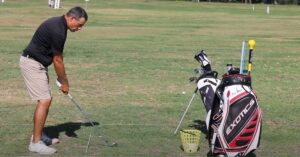How To Hit A Straight Golf Shot? Mastering the Art of Straight Shots
Picture this: you’re standing on the tee box, ready to unleash a powerful drive down the fairway. As you take your stance, your mind brims with anticipation, hoping for that perfect, arrow-straight shot that sails effortlessly through the air.
However, all too often, that ideal trajectory becomes elusive, leaving you to wonder what went wrong.
The key to hitting a straight golf shot lies in a combination of proper setup, alignment, and swing mechanics. Start by ensuring a neutral grip that allows for a natural release of the clubhead through impact. Avoid gripping the club too tightly or with a pronounced tilt, as this can lead to wayward shots.
In this blog post, we will unlock the secrets to achieving that coveted straight shot and help you refine your swing technique to reach new levels of accuracy and precision.
How to Hit a Straight Golf Shot?
A straight golf shot is a golfer’s dream, providing accuracy and control. Proper alignment, grip, and swing mechanics are essential to hit a straight shot consistently.
Follow these steps to improve your chances of hitting a straight shot on the golf course:
Establish Correct Alignment
Align your body parallel to the target line by aiming your feet, hips, and shoulders in the desired direction. Use alignment aids or target markers for reference.
Grip the Club Properly
Hold the club with a neutral grip, ensuring that the “V” formed by your thumb and index finger points towards your trailing shoulder (right shoulder for right-handed golfers).
Maintain a Balanced Stance
Position your feet shoulder-width apart and distribute your weight evenly between both feet. Maintain balance throughout the swing to enhance control and accuracy.
Focus on Ball Position
Place the golf ball slightly ahead of the center in your stance, ensuring it lines up with the inside of your left heel (for right-handed golfers). This promotes a more level strike.
Keep a Square Clubface at Address
Align the clubface square to the target line at the address. Check that the leading edge of the clubface is perpendicular to your target to promote a straight ball flight.
Execute a Controlled Backswing
Swing the club back smoothly, maintaining a one-piece takeaway and avoiding excessive rotation or lateral movement. Keep your arms and wrists relaxed for better club control.
Initiate the Downswing with the Lower Body
Begin the downswing by shifting your weight to your front foot and rotating your hips toward the target. This generates power and promotes an inside-to-square-to-inside swing path.
Maintain a Connected Swing
Keep your arms and body working together throughout the swing. Avoid excessive tension in your grip, wrists, or arms, as it can lead to errant shots.
Maintain a Straight Lead Arm
Focus on keeping your lead arm (left arm for right-handed golfers) straight during the downswing and impact. This promotes a consistent and square clubface at impact.
Follow Through with Balance
Complete your swing with a smooth and balanced follow-through. Extend your arms towards the target and allow your body to rotate naturally. Avoid any sudden movements.
Practice with Alignment and Swing Aids
Utilize alignment sticks, training aids, or practice drills to reinforce correct alignment, swing mechanics, and ball-striking consistency.
9 Grip Techniques for Consistent and Straight Shots
A proper grip is crucial for consistent and straight golf shots. The way you hold the club directly affects the clubface angle, swing path, and overall control. Follow these grip techniques to improve your shot consistency:
1. Neutral Grip
Start by positioning the club in your non-dominant hand (left hand for right-handed golfers). The grip should run diagonally across your fingers from the base of the little finger to the middle joint of the index finger.
2. Placement of the Thumb
Place your left thumb (for right-handed golfers) along the backside of the grip, slightly to the right of the center. The thumb should rest comfortably on the club without excessive pressure.
3. Overlapping Grip or Interlocking Grip
There are two common grip styles: the overlapping grip and the interlocking grip. Experiment with both to see which feels more comfortable and provides better control.
4. Positioning the Trail Hand
With an established lead hand grip, position your trail hand (right hand for right-handed golfers) on the grip. The lifeline of your trail hand should fit snugly over your lead thumb.
5. V-Groove Alignment
When both hands are on the club, they should form a “V” shape between the thumb and index finger. The “V” should point toward your trailing shoulder (right shoulder for right-handed golfers).
6. Pressure Points
Maintain a consistent grip pressure throughout the swing. A grip that is too tight can restrict the clubhead’s movement, while a grip that is too loose can result in a loss of control. Find a comfortable balance.
7. Square Clubface
Check the clubface alignment before gripping the club tightly. Ensure that the clubface is square to the target line, promoting a straighter shot at impact.
8. Avoid Strong or Weak Grips
Be mindful of grip positions that promote a closed (strong) or open (weak) clubface at the address. A neutral grip minimizes the chances of the clubface being misaligned during the swing.
9. Practice and Familiarity
Spend time practicing your grip technique, both on and off the course. Become familiar with the feel of a proper grip and how it influences your swing mechanics.
6 Recommended Drills Or Practice Exercises To Improve Accuracy And Straightness
Accuracy and straightness are crucial skills in various activities, including sports, art, and even everyday tasks.
Whether you’re aiming for a bullseye, drawing a straight line, or simply aligning objects, honing these abilities is essential.
Here are some recommended drills and practice exercises to improve your accuracy and straightness.
1. Focusing On A Target
Select a target, such as a bullseye or a small object, and practice hitting it consistently. Start at a close distance and gradually increase the distance as your accuracy improves. Repeat this exercise regularly to enhance your aim.
2. Line Drawing Exercises
Using a ruler or straight edge, practice drawing straight lines on paper. Begin with short lines and gradually increase their length. Keep the lines as straight as possible and maintain a consistent width throughout.
3. Mirror Exercises
Stand in front of a mirror and perform tasks that require accuracy and straightness, such as brushing your teeth or applying makeup. Use the mirror to observe and correct any deviations from straightness or precision.
4. Balance And Stability Exercises
Improving your balance and stability can contribute to better accuracy and straightness. Incorporate exercises like yoga, pilates, or standing on one leg into your routine.
These activities enhance body awareness and control, positively impacting your accuracy.
5. Slow And Controlled Movements
Practice performing activities with deliberate, slow, and controlled movements. This technique helps you develop fine motor skills and improves your ability to execute precise actions.
Whether it’s typing on a keyboard or shooting a basketball, focus on accuracy over speed.
6. Visualization And Mental Practice
Visualize yourself performing tasks with utmost accuracy and straightness. Engage in mental practice by vividly imagining the movements and actions required.
This technique can enhance your muscle memory and help you achieve better precision when executing the tasks in reality.
10 Common Mistakes to Avoid for Straight Shots
When striving for straight golf shots, there are common mistakes that golfers should avoid to improve their accuracy and consistency. Be mindful of these mistakes and work on correcting them:
1. Poor Alignment
Neglecting proper alignment is a common mistake. Ensure your feet, hips, and shoulders are aligned parallel to the target line to promote a straight shot towards your intended target.
2. Gripping Too Tightly
Gripping the club too tightly can restrict the natural motion of the swing and lead to tension in the hands and arms. Maintain a relaxed grip pressure for better club control and smoother swings.
3. Incorrect Ball Position
Placing the ball too far back in your stance can lead to a swing path that is too steep, resulting in pulls or slices. Ensure the ball is positioned slightly ahead of center for more level contact.
4. Overactive Hands and Wrists
Excessive hand and wrist movement during the swing can cause the clubface to open or close, resulting in wayward shots. Focus on maintaining a stable and controlled release through impact.
5. Swaying or Sliding Hips
Excessive lateral movement of the hips, either swaying or sliding, can disrupt the swing plane and lead to inconsistent ball striking. Keep the lower body stable and rotate the hips smoothly.
6. Over-the-Top Swing
Coming over the top refers to an outside-to-in swing path, leading to slices or pulls. Work on initiating the downswing with the lower body, allowing for an inside-to-square-to-inside path.
7. Lack of Tempo and Rhythm
Rushing the swing or having an erratic tempo can result in inconsistent ball contact. Focus on maintaining a smooth and balanced tempo throughout the swing for better control.
8. Poor Weight Transfer
Insufficient weight transfer can lead to weak shots and a loss of power. Shift your weight onto your front foot during the downswing to promote a more solid strike and better balance.
9. Neglecting Pre-shot Routine
Skipping or rushing through your pre-shot routine can lead to a lack of focus and increased chances of making swing errors. Develop a consistent pre-shot routine to enhance your concentration and shot execution.
10. Lack of Practice and Feedback
Not dedicating enough time to practice and not seeking feedback can hinder improvement. Regular practice, preferably with the guidance of a golf professional, can help identify and correct swing flaws.
Frequently Asked Questions
Welcome to our FAQ section on how to hit a straight golf shot. Whether you’re a beginner or looking to fine-tune your skills, we have answers to common questions that will help you improve your ball striking.
How Important Is The Setup Position For A Straight Shot In Golf?
A proper setup is crucial for hitting straight shots. Align your feet, hips, and shoulders parallel to the target line, square the clubface, and maintain a balanced stance for consistent ball striking.
What Role Does The Swing Path Play In Achieving A Straight Golf Shot?
The swing path greatly influences the ball’s trajectory. Aim for an inside-out swing path, keeping the clubhead slightly behind your hands at impact, allowing the clubface to square up for a straight shot.
How Can I Improve My Clubface Alignment To Hit Straight Golf Shots?
Concentrate on maintaining a square clubface at address and throughout the swing. Visualize the clubface’s position relative to the target and focus on controlling it to hit the ball straight.
What Is The Importance Of Maintaining Balance During A Golf Swing For Straight Shots?
Balance is essential for consistent ball striking. Keep your weight evenly distributed and centered throughout the swing. Avoid swaying or lunging, as it can affect the clubface alignment and lead to errant shots.
Are There Any Specific Tips To Minimize Slicing Or Hooking The Ball For Straight Shots?
To minimize slicing, ensure your grip is not too weak, and focus on an inside-out swing path. Conversely, for hooking, avoid an overly strong grip and strive for an outside-in swing path.
Conclusion
Hitting a straight golf shot requires a combination of proper grip, alignment, swing mechanics, weight transfer, and tempo.
By mastering these fundamental elements and dedicating time to practice, you can unlock the secret to hitting straight shots consistently.
So, step onto the tee box with confidence and watch as your ball soars straight down the fairway, leaving you in awe of your newfound accuracy.






